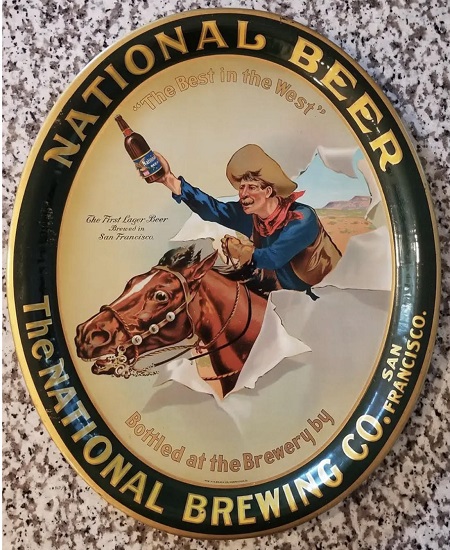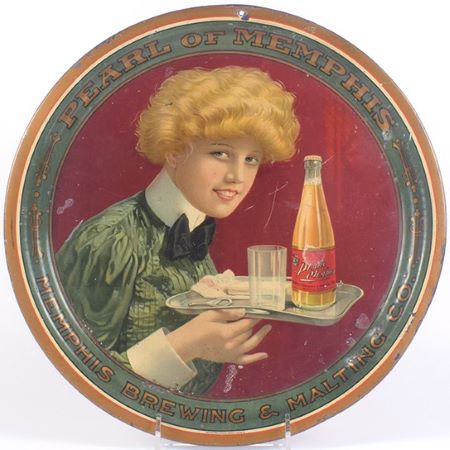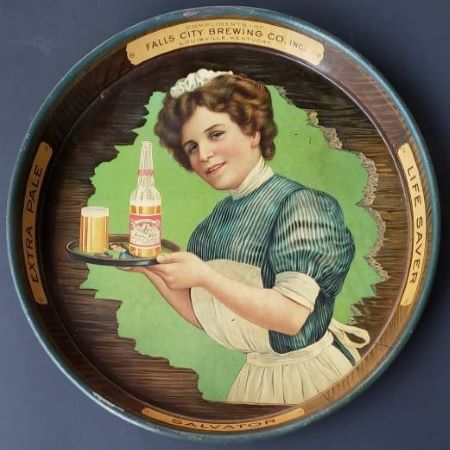General
We’ve long thought of the young woman depicted in this design as a waitress and contemporary pictures from the 1910s confirm that waitresses did wear similar uniforms. There are similar “waitress” images on other brewery trays of the era, both stock and non-stock from a number of the tray manufacturers. However, during the evolution of this project, it’s become clear to us that the more likely occupation of the young lady depicted is some sort of domestic servant.
There are two sides to this argument: first, there has been a common theme among brewery trays to depict beer as an upscale beverage, presumably part of the brewers’ efforts to distinguish beer as a more refined beverage than whiskey, perhaps sparing them from the prohibitionists’ efforts.
Depicting their products being served by a domestic servant in an upper-class home was a far cry from the tawdry environs of the typical saloon of the day (at least in the public imagination). Leading to the second reason: saloons of the day were not considered proper environments for ladies, and other than in hotels, typically didn’t have waitresses, just bartenders who were almost exclusively men.
Kaufmann & Strauss Co. 'Olympia Girl'
to Return to K&S
Stock Catalog Page
Size: 12" 1.25"
Type: SS Dish
Scarcity: Common
Value: $$$
Condition & Brewer Dependent
We are only aware of the examples from Falls City Brewing of Louisville, KY and Pilsen Brewing of Chicago, IL. Interestingly there are variations between these two versions: on the Falls City tray she carries a bottle and glass, while on the Pilsen example it is two glass steins (Images 1 & 2 below). There is also a variation in the “engraved brass” plates that appear on the rim, which is discussed in the Size, Shape and Advertising Placement section below.
- Falls City label—the label on the bottle appears to be based on an actual falls City label that appears in other advertising. Unfortunately we do not have access to the Bob Kay label book that covers Kentucky to verify that it was an actual label used on bottles that were sold.
- Pilsen mugs—we are less attuned to glassware and do not know if the glass steins that appear in this example were actually produced or not. We’ve searched for other Pilsen breweriana that might carry a crest similar to the one on the stein but have also failed to find confirm this was in use at the time. Interestingly, we did find a glass stein with same image of the “Olympia Girl” on it, but no crest on the glass part itself.
We suspect that this design was from the mid-to-later 1910s since there are only these two examples. We are hard pressed to think of any example from K&S that was a universal stock design, used by various advertisers in various industries as was common with the other major manufacturers, particularly the boys from Coshocton. Designs seemed to be either intended for brewery advertisers or non-breweries (ice cream being the most common), although on this one it would have been easy enough to modify so what she was carrying dishes of ice cream instead of beer. But then of course, the barrel part would be superfluous and the need to project an upscale image would be less necessary.




The only examples we have seen have been 12” straight-sided dishes, with the trompe l’oiel conceit of the broken-out beer barrel extending onto the rim, which then also features “engraved brass” plates where the advertising text appears in black text. The faux brass plates on the rim would seem to indicate any earlier date for this design, as that was a common device in earlier tray designs that had faded from use by most manufacturers by the 1910s. It’s always possible K&S was doing a “retro” design kind of thing here given that they seem to have been a later entrant into providing stock designs despite having been producing trays beginning in the late 1890s. The Falls City version has four of these plates with the top one identifying the brewery and the other three (at 3, 6 and 9 o’clock) indicating the types of beers offered. The Pilsen example only has a plate at the top (identifying the brewery) and the bottom, inexplicably titling this image “Olympia Girl”. Olympia was a pre-pro brand of beer they produced at least as early as 1913.
Price
It is a bit of a surprise to us that prices for these trays are not stronger, even though they show up fairly regularly. Better than average to very good examples only go for upper double digits to low triple digits and even an outstanding example only achieved mid-triple digits. Another surprise is that for some reason this design holds up fairly well and most examples we’ve seen have been in better than average condition or better. Both examples show up in fairly equal amounts and we have not noticed a significant difference in price between comparable examples.


This social—and legal—development arose partly because many taverns were being replaced with saloons, with their spittoons covering the counters and piss troughs lining the floors. Many states forbade women from entering these decrepit booze holes, even to chase down a wayward husband. That said, some states allowed women to serve food or service customers, and places like Wisconsin let women enter a saloon—but only through the side door, with privacy screens to shield male customers from their presence.
Places that actually hired women as barmaids suffered legal consequences. In 1892, The New York Times reported a crackdown on six tavern owners who “employed women in dramshops.” Missouri ruled it a felony for women to work in dramshops, bars and concert halls, while Montana women were threatened with arrest and forfeiture. Michigan even didn’t allow women entrance to any place that sold alcohol. Fair or not, there was a bias to assume that any woman who frequented a drinking establishment was at best morally compromised, but most likely a prostitute or “working girl”.
All of which brings us around to our theory that what is being depicted here is a domestic servant bringing beers to her employer. The interesting twist with the Pilsen Brewing example is that she is carrying two beers, perhaps a subtle inference that both the man and lady of the house were enjoying the product. And, if the lady of an upper-class house was enjoying a beer it must be a respectable product.
Design
From a design perspective there are two interesting elements evident; first, this is yet another example of trompe l’oiel, where the view seems to be through the busted-out end of a beer barrel (see Image 3 below). It is a unique perspective that reminds us of The National Brewing Company (San Francisco) tray with the cowboy and horse breaking through to proclaim National Beer “the best in the west.” The other interesting design feature is that the tray she is carrying has the same design of the tray itself on its face. We cannot recall another such clearly self-referential image of a tray on an actual tray.








